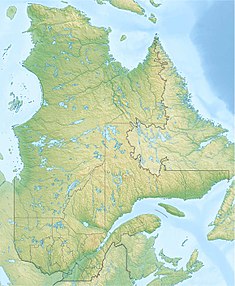Daniel-Johnson Dam
| Daniel-Johnson Dam Barrage Daniel-Johnson |
|
|---|---|
 |
|
|
Location of Daniel-Johnson Dam
Barrage Daniel-Johnson in Quebec |
|
| Location | Manicouagan Regional County Municipality, Quebec, Canada |
| Coordinates | 50°38′48″N 68°43′28″W / 50.64667°N 68.72444°WCoordinates: 50°38′48″N 68°43′28″W / 50.64667°N 68.72444°W |
| Construction began | 1959 |
| Opening date | 1970 |
| Owner(s) | Hydro-Québec |
| Dam and spillways | |
| Type of dam | Concrete, multiple-arch buttress |
| Impounds | Manicouagan River |
| Height | 214 m (702 ft) |
| Length | 1,314 m (4,311 ft) |
| Width (crest) | 3 m (10 ft) |
| Width (base) | 22.5 m (74 ft) |
| Dam volume | 2,200,000 m3 (2,900,000 cu yd) |
| Spillway type | Service, gate-controlled |
| Reservoir | |
| Creates | Manicouagan Reservoir |
| Total capacity | 142 km3 (115,000,000 acre·ft) |
| Catchment area | 29,241 km2 (11,290 sq mi) |
| Surface area | 1,950 km2 (753 sq mi) |
| Power station | |
| Operator(s) | Hydro-Québec |
| Commission date | 1970-71 (Manic-5) 1989-90 (Manic-5-PA) |
| Turbines | 8 x 191 MW Francis-type (Manic-5) 4 x 266 MW Francis-type (Manic-5-PA) |
| Installed capacity | 1,528 MW (Manic-5) 1,064 MW (Manic-5-PA) |
The Daniel-Johnson Dam (French: Barrage Daniel-Johnson), formerly known as Manic-5, is a multiple-arch buttress dam on the Manicouagan River that creates the annular Manicouagan Reservoir. The dam is composed of 14 buttresses and 13 arches and is 214 km (133 mi) north of Baie-Comeau in Quebec, Canada. The dam was constructed between 1959 and 1970 for the purpose of hydroelectric power production and supplies water to the Manic-5 and Manic-5-PA power houses with a combined capacity of 2,596 MW. The dam is 214 m (702 ft) tall, 1,314 m (4,311 ft) long and contains 2,200,000 m3 (2,900,000 cu yd) of concrete, making it the largest dam of its type in the world.
The dam was named after Daniel Johnson, Sr., the 20th Premier of Quebec who was responsible for starting the project while being minister in Duplessis' government. Johnson died on 26 September 1968, on the day he was to preside over the scheduled inauguration of the dam. The facility is owned and operated by Hydro-Québec.
During the summers of 1919 and 1920, hydrological studies were conducted on the Manicouagan and Outardes rivers, flowing into the St. Lawrence near the town of Baie-Comeau. The combined flow was then estimated at 40 million cubic meters, making it one of the largest hydrological systems in Canada. Although harnessing of this potential was considered interesting, its distance from major load centers and the lack of roads in the area were identified as major drawbacks. In addition, building dams in the wilderness was considered too costly.
After the Second World War, the discovery of large iron deposits on the North Shore and the increased forestry activity led to a rapid development of the region. The area's largest cities, Sept-Îles and Baie-Comeau, were now linked to the rest of the province by a road. At the same time, industrial development in southern Quebec required a larger electric supply. Improvements in long distance electric transmission technologies were also a consideration at the time. Significant advances in the field, including the construction of two 315-kilovolt lines, between the Bersimis complex, west of the Manicouagan system, and Montreal, (completed in 1956), lifted another obstacle.
...
Wikipedia

